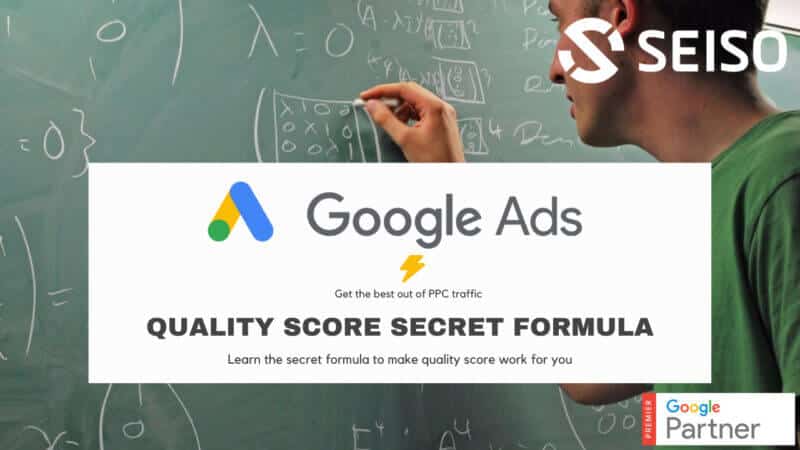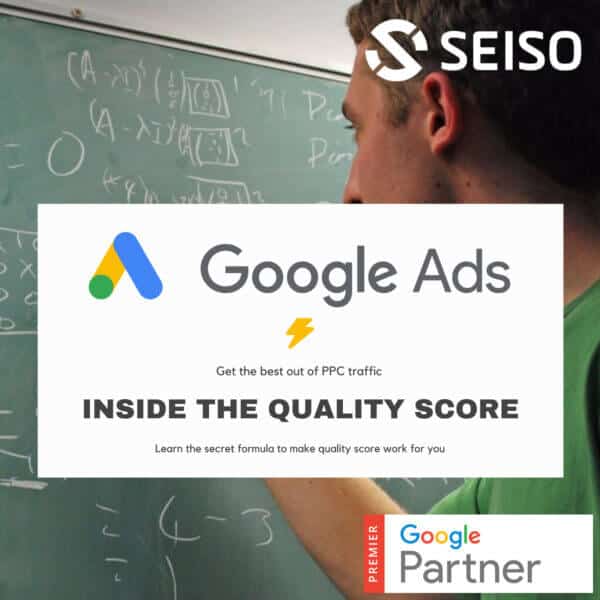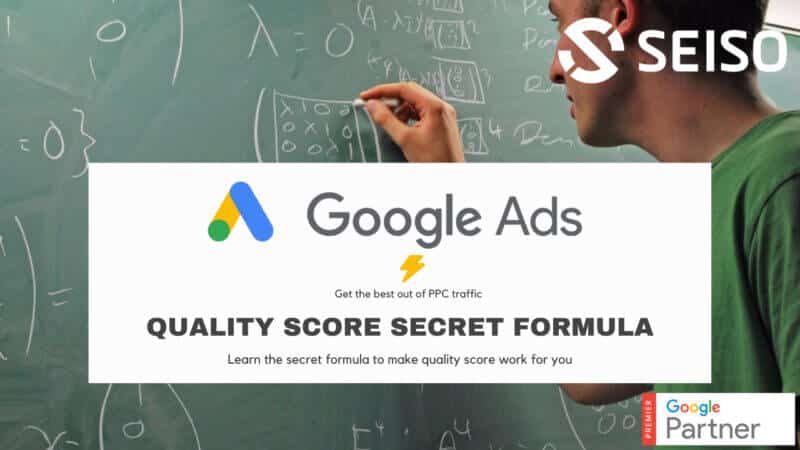
As Peter Drucker famously said: “If you can’t measure it, you can’t improve it.” These are words every digital marketer lives by. But this is only half true. You need to understand what is measured and how it is calculated to be able to take action.
Google gives a Quality Score for each keyword. It affects the CPCs, ad rank and impression share you will get. It will define how profitable your campaign can be. Although Google gives general guidelines on how to improve it, it never revealed how this score is calculated in detail. We analyzed campaigns from over 15,000 advertisers worldwide using SEISO Google Ads campaign optimization tool and have deconstructed its secret formula:
- What is the weighted impact of each component of the QS
- How to prioritize optimizations
- What are the best tactics to improve your Quality Score?
Back to basics: What is the quality score?
The Quality Score is how Google assesses the quality and relevance of your keywords regarding your Ad copies, your landing page, and ultimately, the user. The Quality Score takes a grade from 1 to 10 and 10 being the highest.
Google will apply a bonus or penalty to the price paid per click for this specific keyword depending on the score. Simply said, the higher your Quality Score, the lower your cost per click. To decide the ranking of your ads in the Search Engine Result pages, Google checks the bids and the Quality Scores of all competing ads and ranks them.
Max CPC X Quality Score = AdRank
To improve your position on the page, you have two possibilities: increase your bid or improve your Quality Score. This is why it is key to improve your score in order to minimize your CPC.
The secret sauce, what goes into the recipe?
As officially stated by Google, three components enter in the indicators of the Quality Score: Click-through rate (CTR), Ad Relevance and Landing Page Experience. Each one can be rated: below average, average or above average. Average means the average score compared to your competitors who bid on the same keyword.
The real trick is to understand how much weight is given to each indicator? Is this weighting static or does it depend on verticals or pages? Is there a relationship between keywords in an adgroup?
We analyzed 15 000+ Google Ads accounts and retro-engineered each indicator’s weight and its impact on QS.
And remember this is calculated for each keyword, disregarding its match type of your keywords.
Show me the math: How is the quality score calculated?
The first thing to understand is that the Quality Score is constructed as the sum of its indicators’ values.
You start with 1 – the lowest possible value – and from there add the other points of the QS.
The values are pretty straight forward and presented below:

It almost seems too simple for Google who is known to be using complicated models. This model has been battle-tested across thousands of accounts for more than two years now. To put it in practice, we can check the score with the following example:

For ’Assassins creed Valhalla PS5’
- Basic Quality score is 1 point
- Expected CTR is average so it gives 1.75 points
- Ad Relevance is average so it gives 1 point
The sum makes 3.75 points rounded to a quality score of 4
For ’+ ratchet + clank + ps5’
- Basic Quality score is always 1 point
- Expected CTR is above average so it gives 3.5 points
- Landing page experience is above average so it gives 3.5 points
The sum gives a to a quality score of 8
Now it makes sense to say that the average score is six and not five. We therefore deduce that the standard QS, let’s say rather “neutral” is not five but the sum of the average score + 1. An average keyword will score: 1 + 1.75 + 1 + 1, 75 = 5.5. The Quality Score being an integer value, this will be rounded to 6.
Checking all keywords can be a lengthy process. An easy way to start is to use insight tools such as SEISO Google Ads analyzer report to assist you in the understanding of where you stand.
So what? 3 key take away points
- Improving the CTR or the Landing Page has twice the impact as working on ad relevance.
- The impact of the history of your Google Ads account affecting the quality score is a myth. There is no legacy boost or burden on the quality score level.
- If you already score above average on a given indicator, there is no benefit in improving it any further.
How to improve the quality score of your Google Keywords?
Keep in mind that a high-quality score is Google’s way of saying that your ad is meeting the needs of their users. The more you meet the needs of your potential customers, the more they’ll be satisfied with the Google ad experience, the less Google will charge you for the click of the ad. This is a virtuous circle. Now that you know where to focus your efforts, you can use tools to help you in the optimization process.
1) For Click Through Rate, you’ll first need to exclude unnecessary keywords. Continuously find and exclude irrelevant search terms that waste your budget. Secondly, you will need to refine your match types to avoid showing yourself on irrelevant requests. For example, with a broad targeting on the keyword “car” you will be displayed on the query “engine maintenance.” That won’t fit with your offering if you are a car dealer.
2) With regards to the Landing Page Experience: Mobile experience and page speed are two of the most important items to look after. Another symptom of issues is the bounce rates on your pages that can reveal low relevance of the content and the page with regards to the expectation of the users. The toolset offered by Google with page speed on one hand and analytics on the other is perfectly suited.
Now you know how Google defines the Quality Score for your keywords. Always keep in mind that improving the Expected CTR or the Landing page experience will have twice the impact on quality score points as other actions and should be your priority. But this is only true to a certain extent; once you are above average, there is no benefit.
Key Actions:
- Prioritize your efforts on CTR and the quality of your landing pages:
- Exclude search terms that penalize your CTR
- Optimize your PageSpeed score
- Refine your Match Types
Are your Google Ads Campaigns optimized? To test SEISO for free TODAY, click on this link: www.seiso.io/en

The post Google Ads: The Quality Score formula revealed! appeared first on Search Engine Land.
Source: IAB

